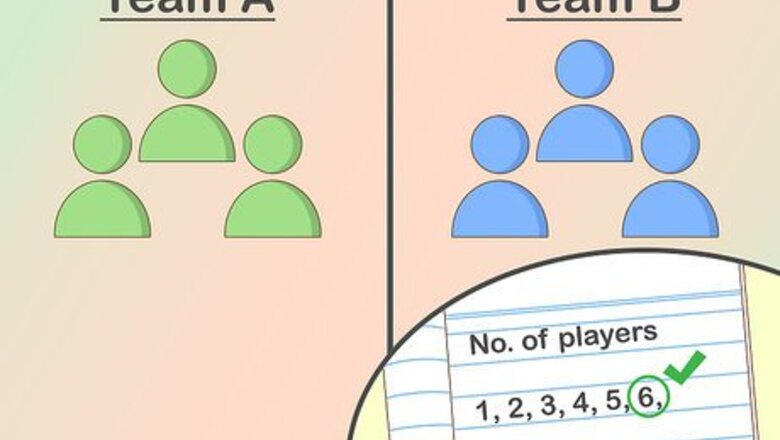
views
Setting up the Game
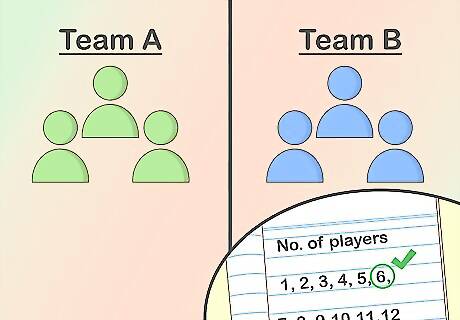
Pick a number of players and divide into teams. You can play Sequence with 2, 3, 4, 6, 8, 9, 10, or 12 people. If there are more than 3 people playing, you’ll need to divide into either 2 or 3 even teams. If there are 4 people playing, break up into 2 teams of 2. If there are 9 people playing, break up into 3 teams of 3. If there are 12 people playing, you can either break into 2 teams of 6 or 3 teams of 4.
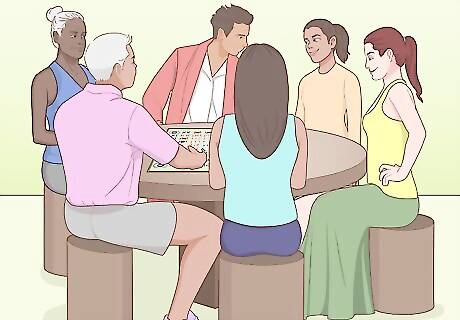
Sit down between opposing teammates. Players must alternate their physical position with opponents. Have each player sit in a seat around a table that’s in between 2 players from the opposing team. This way, each team will have turns in a fair, consistent order throughout the course of the game. Sit around a kitchen or dining room table in order to have ample space for the board, cards, and chips.
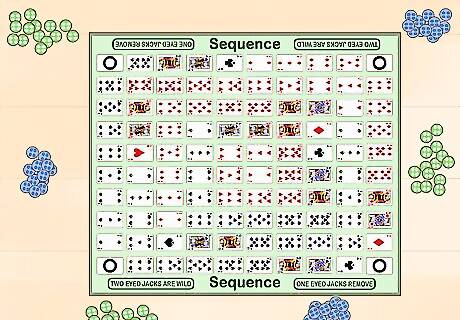
Unfold the board and distribute chips to each player. Take the game board out of the box, unfold it, and lay in flat on the table. Take out the blue chips and green chips if there are 2 teams, and also the red chips if there are 3 teams. Then, decide which team will get which chip color, and divide the chips equally among the players of the team. For example, if 1 team of 2 is blue and 1 team of 2 is green, each member of the blue team will be given half of the blue chips and each member of the green team will be given half of the green chips. The red chips will go back into the box. Only use the red chips if you have more than 2 teams; there are less red chips than there are blue and green.
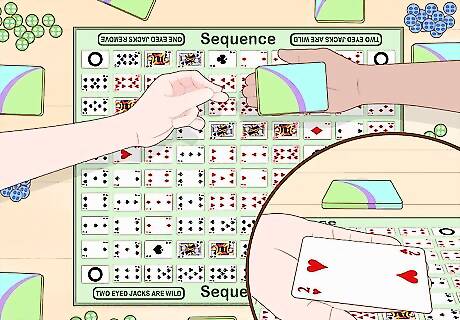
Cut the deck to determine which team goes first. Sequence comes with 2 regular decks of playing cards. Shuffle both decks separately and arrange them into 2 neat stacks with the cards facing down. Put one of the decks off to the side. Have a player from each team cut the other deck by picking up a part of it. Look at the bottom card of each team’s part. Whoever has the lowest card deals first.
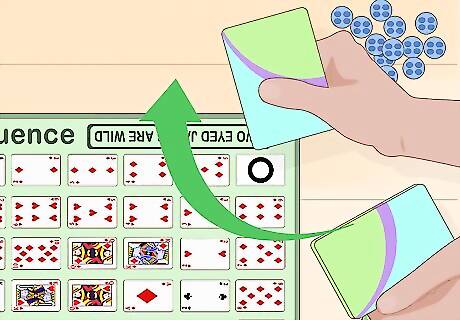
Deal the cards. Have the dealer shuffle the cards and then deal the deck by creating as many piles of cards as there are players. Each pile should have an equal number of cards, which depends on how many people are playing: If there are 2 players, each player gets 7 cards. If there are 3-4 players, each gets 6 cards. If there are 6 players, each gets 5 cards. If there are 8-9 players, each gets 4 cards. If there are 10 players, each gets 3 cards. If there are 12 players, each gets 3 cards.

Start to the left of the dealer and move clockwise. Organize the leftover cards into a stack and place them on top of the other complete deck. Each player will draw from this pile at the end of their turn. Once all of the cards are dealt, the player to the left of the dealer will take their turn to start the game. After their turn is done, have the player to their left go. Continue taking turns in this clockwise fashion throughout the game.
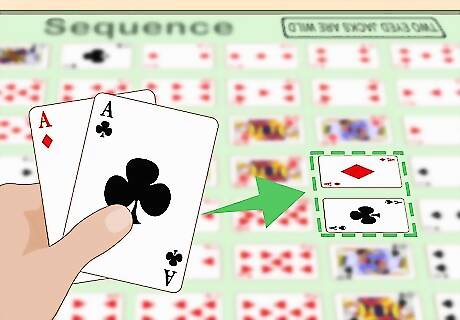
Observe the board. The Sequence board is made up of 100 miniature images of each card in 2 complete decks of playing cards, besides the 4 jacks. As your cards are being dealt to you, become familiar with the board. Try to find the 2 spots that look like smaller versions of each card you have. This way, you can get an idea ahead of time of where you might put your chips.
Taking Turns
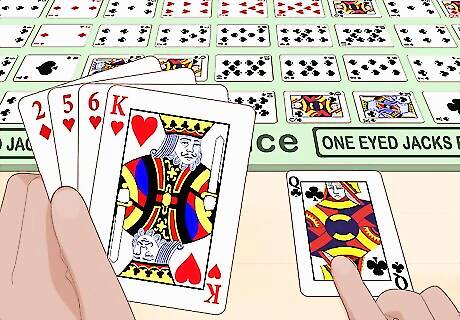
Select a card from your hand to use and discard it. When it’s your turn, take a look at all of your cards and look at the corresponding spaces on the board. Once you’ve chosen which card you want to use, place it in the discard pile so that you can place a chip on the corresponding spot.
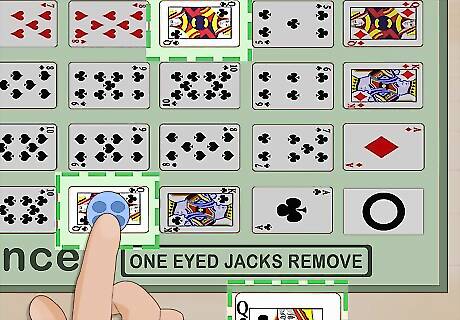
Place a chip on 1 of the 2 board spaces. After you’ve discarded, take 1 of your chips and place it on the board where the card you discarded is represented. Since there are 2 places where each card is represented, you’ll need to decide between them and place the chip on the one you prefer.
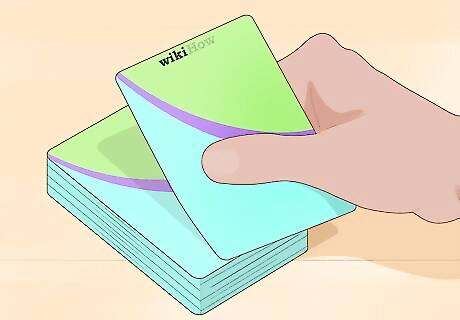
Draw a new card. Finally, you’ll need to finish your turn by drawing a new card to replace the one you just discarded. Don’t forget to do this, or else you may have to continue the rest of the game with 1 less card than everyone else. If you fail to draw a new card before the next player discards theirs, then you no longer have the right to draw a new card for that turn. This is called “Loss of Card.”

Win by getting 1-2 completed sequences first. The object of the game is to get sequences, or 5 chips in a row vertically, horizontally, or diagonally. If you’re playing with 2 teams, then 2 completed sequences are needed in order to win. If there are 3 teams, then only 1 sequence is needed to win. For example, if there is a blue team and a green team and the board has 5 green chips in a row horizontally and 5 green chips in a row vertically and the blue team does not, then the green team wins.
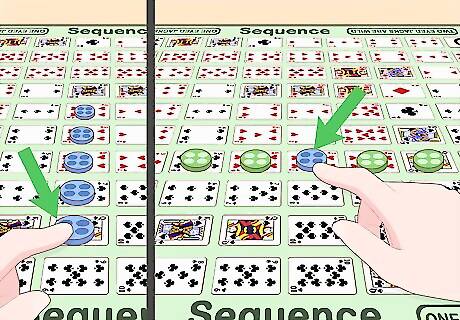
Build your team’s sequences and block your opponent’s sequences. This is the best strategy to have going into each turn. If your team has 3 or 4 chips in a row somewhere on the board, prioritize building onto one of the ends and creating a sequence. If the opposing team has 3 or 4 chips in a row, prioritize blocking them so that they can’t create a sequence.
Understanding the Rules
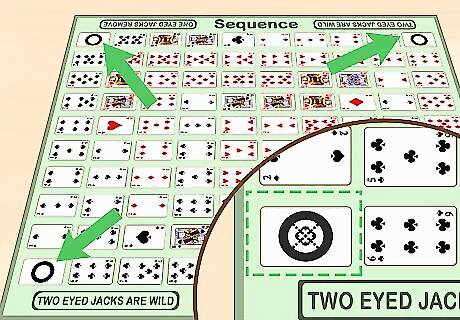
Use the corners as bonus spaces. At each corner of the board, there is a space that doesn’t represent any card. These spaces can be used as bonuses, meaning you only have to have 4 cards to create a sequence if it branches off horizontally, vertically, or diagonally from a corner. Multiple teams can use the same corner space at the same time. For example, if there are 4 blue chips in a row extending horizontally from a bonus corner and 4 green chips extending vertically from that same bonus space, both teams have a completed sequence.
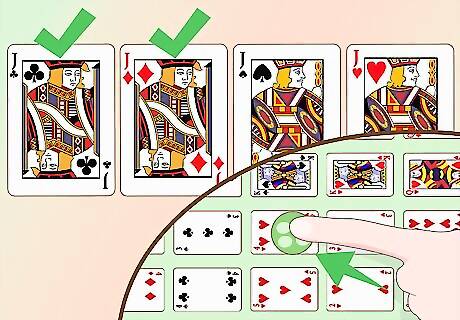
Use two-eyed jacks as wild cards. There are no jacks represented on Sequence boards. This is because they have special uses. If you have a jack and can see both of its eyes on the card, then you can use it to place a chip wherever you want once it’s your turn. It’s a good idea to hold onto your two-eyed jack until you only need 1 more card to complete a sequence.

Take away a chip with a one-eyed jack. If you can only see 1 eye on your jack card, then you can use it as a anti-wild card. This means that you can remove any chip from the board once it’s your turn, as long as it isn’t from a sequence that has already been completed. Take away an opponent’s chip to keep them from completing a sequence.
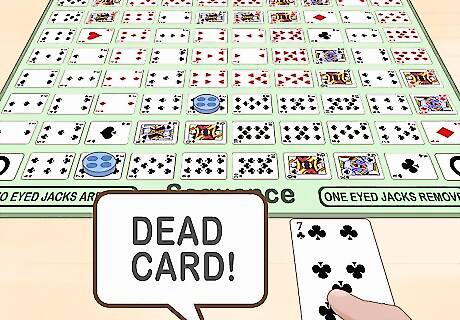
Say “dead card” if chips already cover both spots for a card you have. You may end up with a card that you can’t use because chips are already covering both of the spots on the board that represent it. If this happens, say “dead card” and place it in the discard pile at the beginning of your turn. Then complete your turn as you normally would.
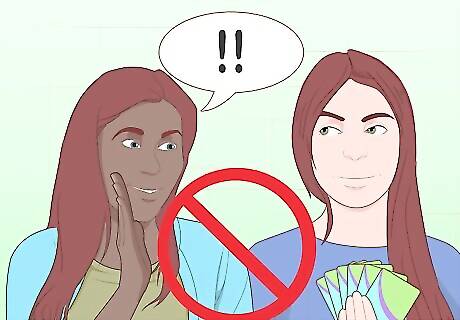
Don’t coach your teammate. In Sequence, it’s against the rules to encourage your teammate(s) to or discourage your teammate(s) from making certain moves or having certain strategies. If you do this, then each member of your team must discard a card of their choice as punishment.



















Comments
0 comment